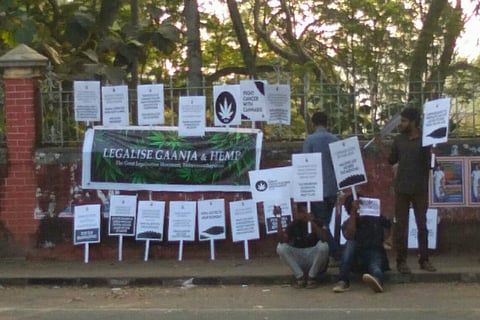

“Leeeeegalise it!” sang a lone voice, as around 15 others marched behind him at a lazy pace, holding posters and banners that called for the legalisation of ganja and hemp.
“I’ll advertiseeee it!” the slow singing continued, intermittently. “Don’t criticiseeeee it!” they sang, as another person slowly joined in: “Leeeeegalise it!”
This was the march organised by The Great Legalisation Movement India (GLM) in Thiruvananthapuram on Sunday. By all accepted standards, the march was neither large nor popular, yet, the ambling youngsters have managed to frustrate people in Kerala. No, not the conservatives – but activists in the state capital.
The march took place at Manaveeyam Veedhi – considered the cultural corridor of the city, where several movements have hosted their agitations, and several artists have performed. And the activists who use Manaveeyam Road frequently have taken offence to the ‘legalise ganja’ march: They say, that as it is, the police believe anyone who comes to Manaveeyam Road to either protest or participate in some cultural activity is a “drug user”, and the march by GLM is only adding to that image.
Ratheesh Rohini, one of the activists who has been involved in the transformation of Manaveeyam Veedhi as a cultural corridor, took to Facebook to slam the legalise ganja protest.
“We have been facing many ridiculing comments which are born of such thoughts (that all activists are drug addicts). The demand of those who were gathered was to legalise ganja, and allow for its use in public spaces. What they say is that ganja can cure cancer. I have requested them to end the march as someone who has never used drugs in life. I have registered strong protest against the gathering,” Ratheesh wrote.
Ratheesh then went a step further and asked why no action was taken by the police against the people demanding legalisation of ganja.
“It is indeed a shame that the police – who would otherwise accuse people who are simply at Manaveeyam Veedhi of keeping ganja, and often beat them up – did nothing in this case,” he wrote.
What is The Great Legalisation Movement India?
The demand to legalise ganja, or marijuana, is not new in India. In fact, until 1985, when the Narcotics, Drugs and Psychotropic Substances Act was passed by the Rajiv Gandhi government, marijuana and hemp were legally sold in India. The government decided to ban them under US pressure, and since then, there have been several voices than have spoken for legalising ganja again.
In fact, most recently, a Member of Parliament from Punjab brought in a Private Member’s Bill to legalise marijuana in the country.
Amidst these voices, The Great Legalisation Movement India was started in 2014 by Viki Vaurora. According to their website, they want “to make this world a better place by educating our People, Government, Doctors, Industries and Entrepreneurs about the benefits of the greatest plant on earth... "CANNABIS".”
Talking about the medicinal uses of ganja, the movement demands that both cannabis and hemp plants be ‘freed’ of governmental regulation.
“Let people have the freedom to grow Cannabis. People should have the rights to use the plant; Medicinally, Spiritually or for their Stress Relief. Allow medical research and hemp industries to flourish across the nation. Release all the people arrested for Cannabis trade in the past 31 years of prohibition in India,” they demand.